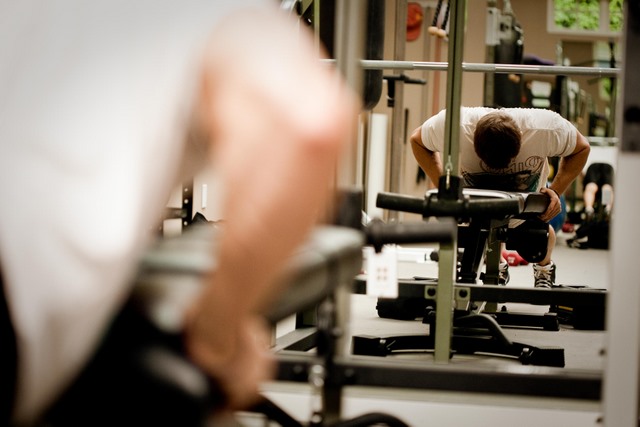
The old notion that more is better shouldn’t apply to the duration or frequency of your workouts. I wasted years over-training, and getting slim to nothing in the way of results from a strength and aesthetics perspective. But it didn’t have to be that way.
I just finished a 25-minute workout using giant sets that focused on 3 muscle groups. It was an awesome workout. I was in a bit of a pinch for time, but I wasn’t about to waste a workout skipping out on the sets that I wanted to cover. It was as good if not better than a previous workout I had done that took 45 minutes.
If you had a choice between a 2 hour workout, and a 30-minute workout, and the 30-minute workout got you better results, which would you choose? It’s a stupid question I’ll admit. But too many of us are blindly choosing the 2 hour workout, when we could increase our gains, and have a more intense, fun, and challenging workout if we incorporated a few techniques into a shorter time period.
Here are a few tips you can use in your training, to cut down on time, and increase results:
1. The Challenge Workout
There are two kinds of challenge workouts:
1) A list of exercises with a set rep count. You go through the list, finishing every rep of every exercise chronologically until you’ve finished. You time the entire workout from the first rep to the last. However long it takes for you to finish the workout, that is your score.
I love these workouts because I add weight each week, but I also try and drop my time each week. I’ve had some of my best results using these workouts and they can last anywhere from 20-45 minutes. Oh yea, and you don’t have scheduled rest periods, you simply rest minimally when you can go no further.
2) You have a list of exercises, but no set rep count. Give yourself 60 seconds to complete as many push-ups (for example), and a few other exercises. Rest 15 seconds in between each 60-second time limit.
The amount of reps you complete of each exercise is your score. You keep the same weight by try and increase the number of repetitions you can complete every time you do the workout. This is more of a test or a gauge to see how your fitness level is improving.
2. Vary Your Sets
Supersets are two exercises back-to-back with no rest period between them. Your rest period is after the second exercise.
Example: (you can superset the same, or opposing muscle groups – your choice)
A1. Bench Press
A2. Yates Row
Giant sets are three exercises done back-to-back with no rest period between them. Your rest period comes after the third exercise has been completed.
Example:
A1. Military Press
A2. Bent-over Lateral Raise
A3. Seated Lateral Raise
Both supersets and giant sets are great ways to double up – or triple up – exercises to increase muscle damage, burn, and lactic acid, while decreasing time. Remember, you want to break down your muscle in as little time possible. It’s in recovery that we build that muscle back up.
If our workout is too long, we release cortisol – a muscle and bone-eating hormone involved in our fight or flight mechanism. By keeping our workouts short and intense, we are ensuring that our hormones are on our side.
3. Keep Your Eye On The Clock – And Have PLAN!
I see this all the time in the gym, and I’m guessing you do to:
Guys wandering around for 5 minutes in between sets, totally oblivious to what their rest periods are. You also see guys wandering around with a puzzled look on their faces trying to figure out what they should be doing next.
I was there and I used to to that too. So I know how ineffective that kind of training is. You have to know what you’re going to be doing before you walk into the gym. This could mean writing your own program – or getting someone else’s. Either way, your workout has to be clear, and written down.
4. Lift To Failure
A lot of us fitness guys will say that lifting to failure in each set is over-kill. I’m not one of them. I think that lifting to failure – within proper form – in each and every set is the way to go. Most of your muscle damage is going to occur during those last few reps before failure. Everything before those reps is a build up.
What is failure and what does it feel like?
Failure should make you want to quit. It’s painful. It’s your body telling you that it cannot complete even one more rep. Lifting to failure will ensure that you’re not wasting any time in the gym – that you’re getting the absolute most out of every single rep and every single set.
If you’re doing a challenge workout, make sure you complete every single repetition you can possibly complete before taking a minimal rest period. If you’re doing a more conventional workout, or using supersets and giant sets, have your goal rep count, and choose weight accordingly. If you choose a weight that’s too light, run with it and lift until you fail. If you choose a weight that’s too heavy and you fall a bit short, make sure that you truly went to failure.
Lifting to failure will make sure that you’re getting the most bang-for-your-buck. If you want to drop your training time, you’ll need to make sure that every set you do is of the highest quality.
*Also, make sure to keep your training to a maximum of 4-days a week, get your 8 hours of sleep each night and eat the right foods at the right time. Recovery is the second have of the equation, and something that we didn’t talk about in this article.
If I had to add one more…
Changing your cardio from steady-state, to HIIT is a great way to cut down on time but increase results. High Intensity Interval Training has been shown to burn more fat in less time, while helping us maintain muscle. Whereas longer bouts of cardio can result in the use of muscle for fuel.
Try a 2:1 sprint to jog or walk ratio when you’re in the gym next time. Sprint for 30 seconds, coast for 60 seconds. Repeat for 8-10 minutes. You can also do this skipping, on the bike, or probably the best method: outside.
Check Out the Ripped Muscle-Building Solution that Helped Me Gain 32 Pounds of Ripped, Athletic Muscle in 32 Weeks
_____________________________
Find this article Helpful?
Sign up below for weekly updates, training and lifestyle tips that aren’t found on the blog:

